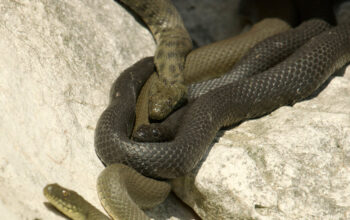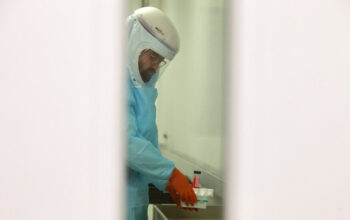
Snakes can’t really unhinge their jaws, but for some, that doesn’t get in the way of swallowing absurdly large prey.
For instance, Burmese pythons, like the invasive ones making their way north in Florida, have been known to consume 70-pound deer and 100-pound alligators.
But new research indicates that, relative to their size, the snakes that can gulp down the largest meals are harmless, three-foot-long egg eaters.
“This particular group of snakes may be No. 1 when it comes to big mouths in the snake kingdom,” said Bruce Jayne, a biology professor at the University of Cincinnati and the author of a paper on the subject published this month in the Journal of Zoology.
The snakes in question, of the genus Dasypeltis, are found throughout Africa, and they’ve been primed by evolution for gulping down bird eggs.
They’re small, skinny and nearly toothless, since teeth prove to be a hindrance with their food of choice. “If you are a generalized snake, with long, thin, pointy teeth, and then you’re trying to swallow something that is basically like a rock, because it is so hard and unyielding, you’re very likely to wind up with a bunch of broken teeth,” Dr. Jayne said.
These snakes also don’t have venom. If they’re threatened, they mimic venomous vipers by flattening their heads and rubbing their scales together to produce a hissing sound.
While they’re pretty useless at hunting non-egg prey, they’re very good at what they do. Dasypeltis snakes have specially shaped vertebrae to help crush an egg once it’s swallowed, and perhaps most importantly, special adaptations to their skin and jaws that allow them to open their mouths extra wide.
The lower jaws of snakes are two separate pieces of bone, joined by connective tissue at the “chin.” This connective tissue, and the skin covering it, are capable of stretching to increase the size of the snake’s mouth.
To estimate the maximum size prey a snake is capable of swallowing, “historically, folks have concentrated quite a lot on the dimensions of the bones,” Dr. Jayne said. “If you only measure the bones, you’re not really accounting for the mobility of the bones, and you’re certainly not accounting for the ability of those soft tissues to stretch.”
To test the snakes’ mouth-opening capabilities, Dr. Jayne compared the euthanized bodies of 15 Dasypeltis gansi egg-eaters and 17 yellow rat snakes. When he inserted a series of 3D-printed plastic probes to measure the maximum open mouth area, or “gape,” he found that Dasypeltis gansi “has spectacularly stretchy skin,” enabling it to “add more than 50 percent of that gape area,” he said. The rat snakes’ gape could only expand by about 19 percent.
A previous study by Dr. Jayne showed that stretchy tissue in Burmese pythons’ jaws allows them to expand their gape by 43 percent — less than the Dasypeltis egg-eaters. Dr. Jayne suspects that Dasypeltis might have the biggest relative gape in the entire snake family.
Bryan Maritz, an associate professor of biology at the University of the Western Cape in South Africa, who was not involved with the study, has also been part of research that, in his words, aims to figure out “how the hell does a tiny, tiny snake like this swallow a bird egg.”
Dr. Maritz said Dr. Jayne’s study stands out because it upends traditional thinking when it comes to estimating the size of prey a snake can swallow. “We’ve always just relied on proxies for snake gape. We’ve said, ‘Well, gape is correlated broadly with head length, and so you can measure a snake’s head length and you can estimate its gape.’ And this study really shows that that’s not the case.”
The study’s findings might encourage research into what sorts of prey snakes are capable of eating, and the evolutionary trade-offs involved in being great at eating eggs but bad at eating just about anything else. Dr. Jayne said that studying the structure of snakes’ skin might yield medical advances related to surgery, or even childbirth.
“This diversity that evolution has produced, I think, can really just be awe-inspiring when you think of what’s out there in nature and how we biologists have only touched the tip of the iceberg for what we know,” Dr. Jayne said.



